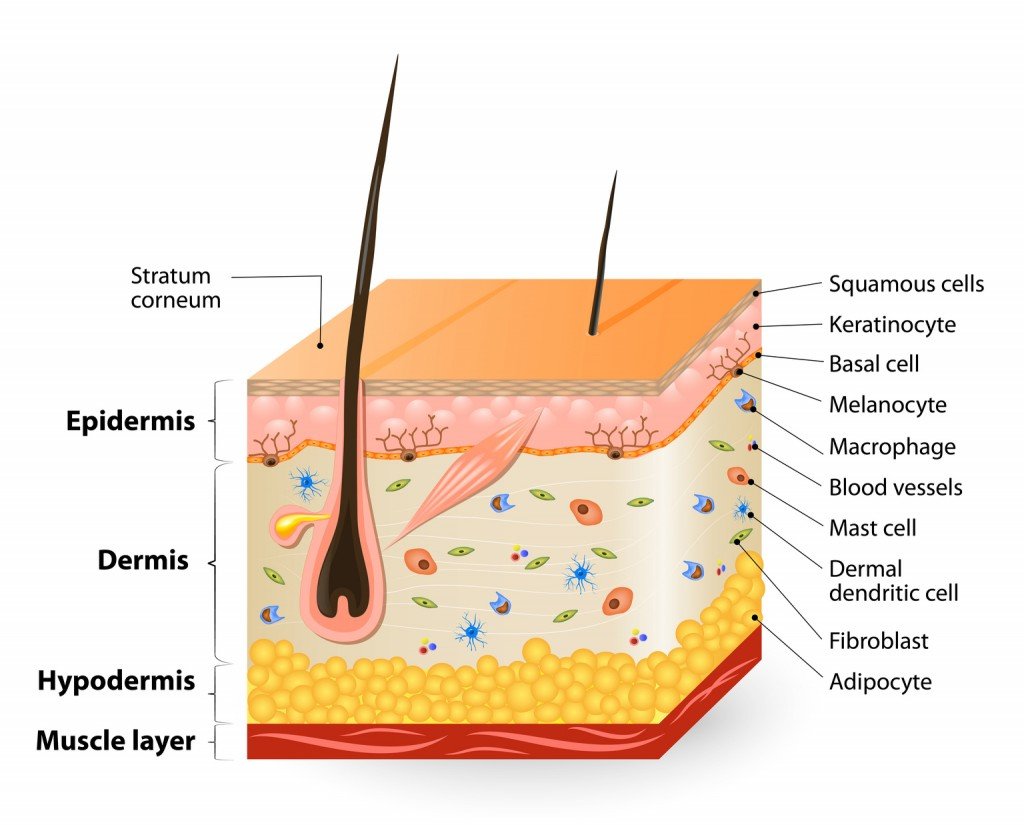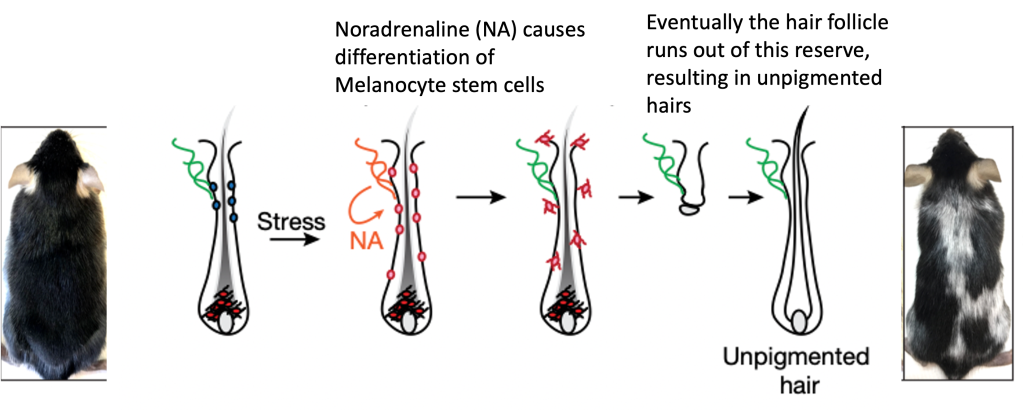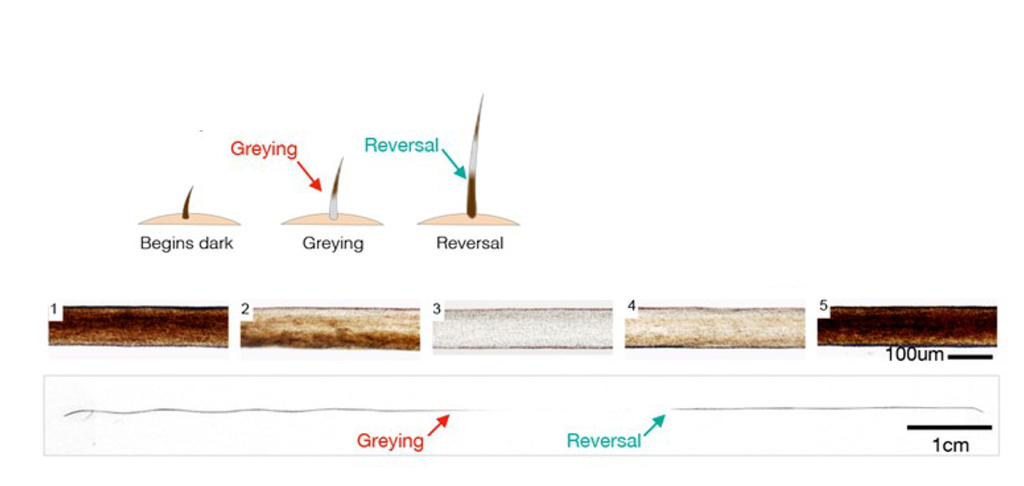Table of Contents (click to expand)
Stress can lead to gray hair, but there is much more to the story. A study by Rosenberg and her colleagues conclusively shows that stress levels can be quantitatively mapped onto hair pigmentation patterns. More interestingly, they showed that this graying is actually reversible!
The idea that stress can cause one’s hair to turn gray is often referred to in movies, TV shows, and in pop culture. One famous example is former US President Barack Obama, who had black hair when he started his job, but had gray hair by the time he was done running a country for two terms!
While examples like this are hard to deny, researchers are not so quick to jump on this cause-and-effect bandwagon. How exactly does stress turn black hair white in not-so-old people? And is it caused by stress, or something else entirely?
The Science Of Gray Hair
Everyone has some hair color (unless you have a pigment deficiency or certain disorders). This coloring process begins deep down in the follicles of the head. At the base of our hair follicles are skin cells called keratinocytes that gradually, millimeter by millimeter, build up our hair cells. The hair that keratinocytes make isn’t colored. While the construction process is occurring, another type of cell called melanocytes are hard at work producing a pigment called melanin and delivering it to the keratinocytes. The new hair hair finally gets some color through that delivery!

This melanin for hair comes in two varieties: brown/black and yellow/orange. Some combination of those color patterns results in the endless variety of hair shades that we see in the world around us.
Your little cells keep creating and painting your hair, right from the moment you’re born, but not until the moment you die. These cells are far from immortal, and like most other parts of the body, they break down over time. A hair follicle only remains in production for periods of 2-7 years, and you know they’ve shut down when the hair falls out.
However, as you can see, many of us still have a full head of hair past this 2-7 year deadline. The body taps into stem cell reserves that form new keratinocytes and melanocytes, but these reserves aren’t infinite either. As it turns out, keratinocyte stem cells seem to have a longer shelf life than melanocyte stem cells, which is why people with gray hair continue having to get haircuts.
The crux of this article, however, is whether stress has an effect on this graying process, which is where the discussion gets a bit confusing.
Also Read: Why Do We Lose Hair From Our Head, But Not The Rest Of Our Body?
Genetics Vs. Stress
There is no denying that genetics is involved in how your hair grows. Early balding, early graying, and male pattern baldness are decidedly hereditary. Your genes determine the number of stem cells you have and the amount of time your follicles grow hair before shutting down. We can’t do much about these basics of our genetic makeup.
However, stress is something we can control. Elevated levels of stress result in elevated levels of stress hormones. Stress hormones—adrenaline, cortisol and norepinephrine—are not necessarily evil things in the body; in fact, we need stress hormones to activate certain muscle groups (many of your skeletal muscles) and provide boosts of energy when we need them (the famous “adrenaline” rush), more commonly known as the “fight or flight” response of the body.
That said, it can be a double-edged sword. High and chronic levels of stress hormones in the body cause inflammation in the tissues and cells of the body. Increased inflammation can lead to a breakdown of your immunity, accelerate the aging process, and increase your risk of communicable and non-communicable diseases.

A breakthrough study in mice showed that stress causes the release of noradrenaline near the base of the hair follicles. This noradrenaline pushes all the melanocyte stem cells here to become melanocytes. Essentially, it depletes the animal’s reserve. When the melanocytes finally die, what these mice are left with are hairs that no longer have any more pigment-producing cells. Et voila! Silver mice!
Also Read: Why Do Men Often Go Bald, But Women Rarely Do?
Graying In Mice Vs. Graying In Humans
It is one thing to show that stress turns black-haired mice silver, but mice are different from us in many ways. One area that suffers from this difference is the field of neurology. Mice brains are structured slightly differently from the brains of humans, but does this hold for hairs as well?
Luckily, in another breakthrough study in 2021, researcher Ayelet M Rosenberg and her colleagues finally managed to validate the role of stress in gray hairs in humans. Ayelet decided to use a simple approach of looking at stress events parallel to any changes in the hair. To look at hair as closely as possible, they used the most powerful microscope approach—electron microscopy. To analyze the stress levels, they asked the participants of the study to fill out a retrospective psychosocial stress assessment test.
Using the electron microscopy images, they could observe the various pigmentation patterns on the hair shaft. Using the average growth rate of human hair, they were able to trace back any life events to a particular segment on the hair shaft. For example, if you took a healthy growing child, you could make a rough estimate of his age based on his height. Well, Ayelet and her colleagues did just that.
They were able to map out changes in the hair shaft aligned with various life events that occurred in the donor, as they self-reported in the questionnaire. Our hairs permanently hold information about our biological past—a scientific pensieve!
Electron microscopy video of a hair shaft allows one to see the distinct graying of hair—and its reversal!
The study conclusively shows that stress levels can change your hair color. They showed that one sample of 5 hairs of a person had a distinct graying. They back-calculated this graying to 2 months of apparent stress-induced hair changes. Upon going back to the donor of the hair sample, the stress assessment test showed that this period coincided with one of the most stressful events of the participant’s life, graded as a 9/10! The participant was going through a marital separation that ended in relocation.
The Good News!
This study is referred to as a breakthrough for another exciting reason! Apart from directly demonstrating stress-induced graying of hair, the authors were also able to show that decreased levels of stress can reverse this graying process!

Upon looking at the hairs on the scalp of a 35-year-old Caucasian male with auburn-colored hair, they saw a grey hair return to its original color. This reversal coincided with 1 month of the man’s lowest reported stress, 0/10. The man had gone on a 2-week vacation just before this period. This is scientific proof that we need vacations to keep us feeling—and looking—young!
Scientists had earlier considered graying to occur due to a loss of certain proteins responsible for hair color. However, this study revealed that stress causes an increase in certain proteins in the hair shaft that causes graying. The concept of an increase in specific proteins, rather than their absence, overturned the previous doctrine accepted in the field.
What’s The Gist?
As we age, inevitably, our keratinocytes and melanocytes will naturally begin to die off or shut down, leaving us in a world of silver foxes and gray-haired goddesses; however, if you want to slow that inevitable fade to white, cutting down on stress is one way to stay young. If that doesn’t work, just take a vacation!
How well do you understand the article above!

References (click to expand)
- What Causes Hair Loss in Men? - www.webmd.com
- Fact or Fiction?: Stress Causes Gray Hair. Scientific American
- You Asked: Can Stress Cause Gray Hair?. Time
- B Zhang. (2020) Hyperactivation of Sympathetic Nerves Drives Melanocyte .... National Center for Biotechnology Information
- Rosenberg, A. M., Rausser, S., Ren, J., Mosharov, E. V., Sturm, G., Ogden, R. T., … Picard, M. (2021, June 22). Quantitative mapping of human hair greying and reversal in relation to life stress. eLife. eLife Sciences Publications, Ltd.
